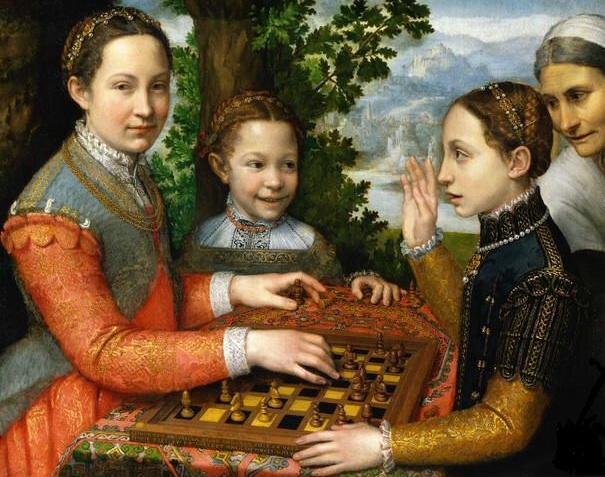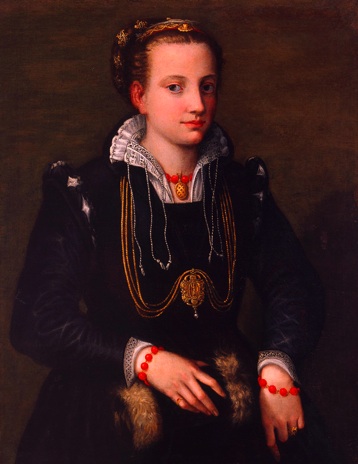Every month, I profile an artist who inspires my own art, in several segments.
When she was a young woman, Sofonisba Anguissola was limited in her ability to paint strangers. Before she traveled to Rome at the age of 22, she was only able to paint her family.
Working within this limitation resulted in lovely paintings of her family members. These (and other) paintings were described by her contemporaries as “alive”, a word that was never used to describe the paintings of female artists in the Renaissance.* Additionally, some of her portraits were far more casual than the norm, and give us not only a window into noble Italian life (pastimes, clothing, house interiors, etc.), but also hint at the personalities of and relationships between her family members.
Sofonisba’s immediate family consisted of her noble parents, father Amilcare Anguissola and mother Bianca Ponzone; younger sisters Elena, Lucia, Europa, Minerva and Anna Maria; and younger brother (and presumably the youngest sibling) Asdrubale. Elena, Lucia, Europa, and Anna Maria all painted, but Elena quit upon becoming a nun, Lucia died young, and the last two sisters’ marriages prevented them from continuing their art. Minerva was a Latin scholar and writer, and Asdrubale gravitated toward music and Latin.

Elena Anguissola as a nun (1551)
This is probably Elena, the second-oldest sister. She also apprenticed with Bernadino Campi, but stopped painting when she became a nun. (She wasn’t officially registered as a nun until 1585, though.) This portrait is fairly standard for the time.

The Chess Game (1555)
My goodness. This painting of Sofonisba’s sisters (Lucia, Minerva and Europa) and their servant is the one that makes it into the art history books, and rightly so. It is indeed filled with life – Minerva’s grin, Lucia pausing before releasing her chess piece, Europa’s raised hand and parted lips, and the servant’s interest in the game. It’s also a painting of children, and girl children at that. This painting is simply remarkable.
As Frederika H. Jacobs says, “She was able to master the intricacies of response, in part, by recasting the format of formal portraiture into an informal grouping of figures engaged in a single unifying activity.”*

Portrait of the Artist’s Sisters and Brother (c. 1555)**
Judging from their sizes, I assume these are the youngest three children: Minerva, Asdrubale, and Anna Maria. They’re kind of funny – especially Asdrubale in the middle, raising his eyebrows like he knows he’s all that. Minerva looks like she might be holding back a giggle.

Bianca Ponzoni Anguissola (c. 1557)
Bianca Ponzoni, the mother of the seven Anguissola children, was from a noble family. She may have died a year or two after she gave birth to her last child, but I can’t confirm it. Her portrait is staged in the typical manner – seated, wearing luxurious clothing and jewelry – but there’s a little something about her face that speaks to her personality. I don’t know what it is, but I like it.

Minerva, Amilcare, and Asdrubale Anguissola (c. 1558)
Although her father seems a bit stoic in this family portrait, it’s still a nice picture. I like it: Minerva holding flowers and the father and son touching, with the dog just hanging out in the lower right corner. I also don’t recall seeing any Renaissance-era portraits that show fathers and sons this close, or that feature a daughter with her father.

Minerva Anguissola c. 1564 (year unknown)
This painting was previously thought to be a self portrait. (Actually, I found a nearly-identical painting and initially put it on the self portrait page – you can see how I’d make that mistake.) Minerva was a Latin scholar and writer, but died in 1564. She would have been in her mid- or late twenties. Sofonisba probably painted this from that earlier not-self-portrait I mentioned.
*Frederika H. Jacob wrote a fascinating article, “Woman’s Capacity to Create: The Unusual Case of Sofonisba Anguissola” (Renaissance Quarterly, Vol. 47, No. 1, Spring, 1994, pg. 74-101). In it, she discusses the prevailing “understanding” of conception during the Renaissance – “active” male sperm forming bodies from the “passive” female material in the womb – and how this affected how men talked about women’s art. Basically, the male writers of the time decided that, because women did contribute a little bit to babies (because being preggers and giving birth is such a breeze, LOL), they could be artists – but because they didn’t contribute any “soul” or spirit, they could never be great artists: as in, imbuing portraits with life. Jacob explores these issues and points out the only exception to this attitude about women artists was Sofonisba Anguissola, whose art was frequently described as life-like.
**I found the image at It’s About Time, a website I’ve only begun to explore.
Other parts in the Sofonisba Anguissola artist profile series
Introduction
Self portraits
Other Portraits
The triple portrait of Adsrubal and his two sisters is at Corsham Court in Wiltshire, it is as you say wonderfully lively, he looks quite pleased with being in the middle and tghe sistgers clearly about to giggle!